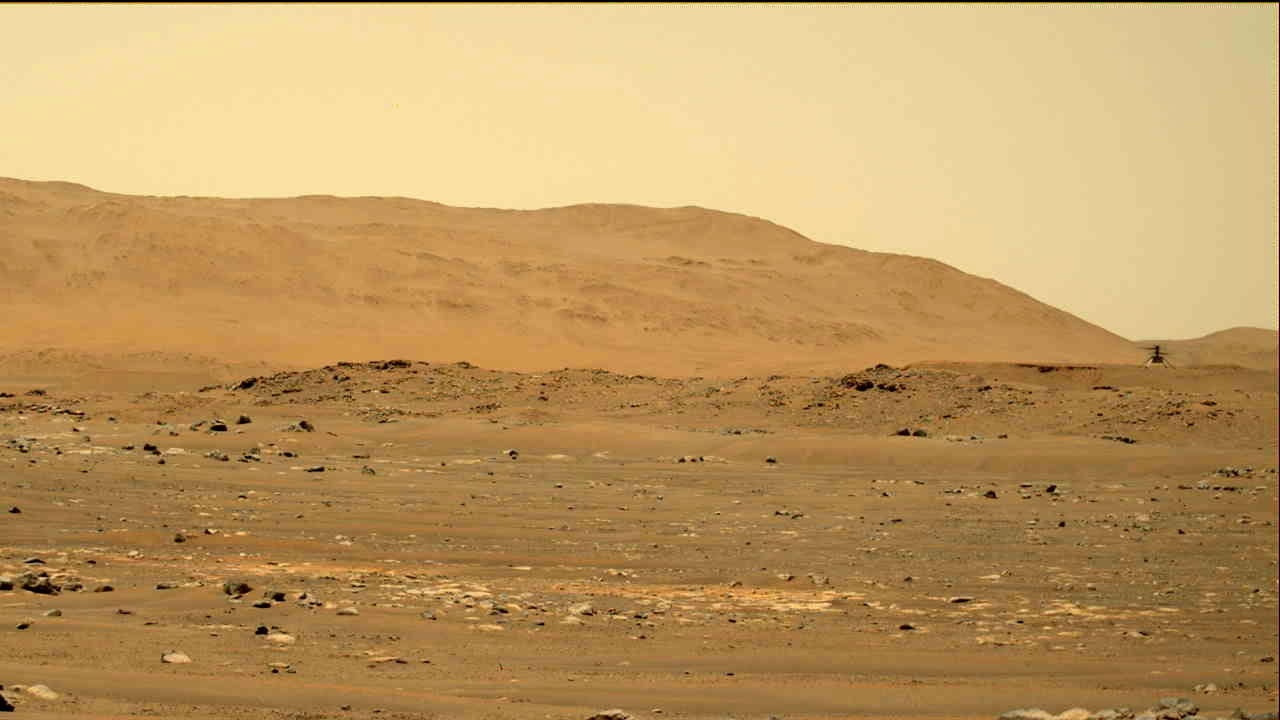We've already seen NASA's Ingenuity helicopter fly on Mars — and now we can hear it, too.
The agency's Perseverance rover captured the whirring of Ingenuity's fast-spinning rotors during the little chopper's fourth Red Planet flight, which took place on April 30, NASA officials announced today (May 7).
The newly released recording, which was made using the microphone on Perseverance's rock-zapping SuperCam instrument, marks the first time one spacecraft has recorded audio of another probe on a world beyond Earth. And it has more than just gee-whiz value, rover team members said.
"This recording will be a gold mine for our understanding of the Martian atmosphere," SuperCam microphone science lead David Mimoun, a professor of planetary science at Institut Supérieur de l'Aéronautique et de l'Espace (ISAE-SUPAERO) in Toulouse, France, said in a statement.
Video: See the view on Mars from Ingenuity helicopter's fourth flight

Join our forums here to discuss the Perseverance rover and Ingenuity helicopter on Mars. What do you hope they find?
Perseverance carries two microphones — the SuperCam instrument mic and one that's part of the rover's entry, descent and landing camera system. Both mics had already captured audio prior to April 30 — the first-ever sound recordings made on the surface of Mars.
Perseverance has captured video of all of Ingenuity's flights to date, from an observation point 262 feet (80 meters) from the chopper's takeoff and landing site. But rover team members didn't try to record audio until sortie number four, explaining that they wanted to make sure that such efforts could not interfere with Perseverance's various systems in any way.
Get the Space.com Newsletter
Breaking space news, the latest updates on rocket launches, skywatching events and more!
And there was certainly no guarantee that SuperCam's mic was going to pick up any rotor chop on April 30.
“This is a very good surprise," Mimoun said. "We had carried out tests and simulations that told us the microphone would barely pick up the sounds of the helicopter, as the Mars atmosphere damps the sound propagation strongly. We have been lucky to register the helicopter at such a distance."
And Ingenuity wasn't quite as noisy as it seems in the recording; team members isolated the rotor chop and clipped out some other frequencies to make the copter easier to hear.
Perseverance and Ingenuity landed together Feb. 18 on the floor of Mars' Jezero Crater, which hosted a lake and a river delta billions of years ago. The 4-lb. (1.8 kilograms) chopper deployed from the rover's belly on April 3, kicking off a technology-demonstrating flight campaign that was supposed to last for a maximum of 30 days.
But Ingenuity has performed so well that it recently got a mission extension. The helicopter is now transitioning into a new phase, during which it will attempt to showcase the scouting potential of Mars rotorcraft.
That new phase will begin in earnest after flight number five, which is scheduled to lift off today at around 3:30 p.m. EDT (1930 GMT). If all goes according to plan, Ingenuity will make its first one-way flight, to a new airfield 423 feet (129 meters) from its current location.
That new spot is along Perseverance's planned traverse. The two robots have to stay relatively close together; communications to and from the solar-powered Ingenuity must go through the car-sized rover.
Perseverance, meanwhile, is getting set to sink its teeth into its own science mission, which has two main goals: hunting for signs of ancient Mars life and collecting and caching dozens of samples for future return to Earth.
SuperCam plays an important role in such work. The instrument allows Perseverance to assess the composition of rocks from afar, helping identify targets worthy of more in-depth investigation. Audio recorded during the rock-zapping process can reveal how hard a rock is and whether or not it has a coating, SuperCam team members have said.
Mike Wall is the author of "Out There" (Grand Central Publishing, 2018; illustrated by Karl Tate), a book about the search for alien life. Follow him on Twitter @michaeldwall. Follow us on Twitter @Spacedotcom or Facebook.
Join our Space Forums to keep talking space on the latest missions, night sky and more! And if you have a news tip, correction or comment, let us know at: community@space.com.

Michael Wall is a Senior Space Writer with Space.com and joined the team in 2010. He primarily covers exoplanets, spaceflight and military space, but has been known to dabble in the space art beat. His book about the search for alien life, "Out There," was published on Nov. 13, 2018. Before becoming a science writer, Michael worked as a herpetologist and wildlife biologist. He has a Ph.D. in evolutionary biology from the University of Sydney, Australia, a bachelor's degree from the University of Arizona, and a graduate certificate in science writing from the University of California, Santa Cruz. To find out what his latest project is, you can follow Michael on Twitter.









